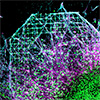| Apr 10, 2025 |
A recent research study has successfully merged two cutting-edge 3D tissue engineering strategies – 3D polymeric scaffolds and 3D neuronal spheroids – to create a highly advanced model for studying neuronal behaviour and disease.
(Nanowerk News) A recent research study (Advanced Healthcare Materials, “Smart Polymeric 3D Microscaffolds Hosting Spheroids for Neuronal Research via Quantum Metrology”) from INL has successfully merged two cutting-edge 3D tissue engineering strategies – 3D polymeric scaffolds and 3D neuronal spheroids – to create a highly advanced model for studying neuronal behaviour and disease.
|
|
The collaboration between biomedical engineers, physicists, and neuroscientists has led to the development of a smart polymeric scaffold integrated with fluorescent nanodiamonds, that reveals to be a powerful quantum sensing tool.
|
|
These low auto-fluorescence scaffolds, fabricated using laser-based 3D microprinting, were designed to be both biocompatible and capable of hosting 3D neuronal spheroids. The fluorescent nanodiamonds embedded within the scaffolds provide the potential for real-time monitoring of magnetic signals and temperature shifts at the nanoscale, providing a new level of precision in studying cellular signalling, disease mechanisms, and drug responses.
|
 |
| Multicolour confocal microscopy image of a 3D neuronal model, interfacing a smart 3D polymer scaffold. (Image courtesy of the researchers)
|
|
Beatriz Costa, the first author of this study, emphasises the significance of the work: “The use of low-autofluorescence 3D polymeric scaffolds enabled the integration of quantum metrology techniques with nanodiamonds. When combined with 3D neuronal cell aggregates, this approach holds great potential for in-depth studies of neurodegenerative diseases and beyond.”
|
|
The study’s success lies in its ability to use these scaffolds to host dopaminergic neurons, crucial to Parkinson’s disease research, and demonstrate the neurons’ directional growth along the scaffold. This not only validates the model’s ability to support complex neuronal cultures but also unlocks new possibilities for exploring neurodegenerative diseases.
|
|
Jana Nieder, principal investigator of the project at INL, explains the broader implications: “With this study, we open the pathway to have an in vitro brain organoid system equipped with quantum sensors. The readout of these sensors will allow us to investigate healthy and disease-related neuronal communication patterns. This provides a platform for studying neurodegenerative diseases like Parkinson’s, while also being adaptable to other medical fields.”
|
|
This research, supported by the Diamond4Brain project funded by the La Caixa Foundation and FCT, results from a collaboration between INL and ICVS further solidifying the potential of this innovative platform to revolutionise both disease research and therapeutic development.
|


